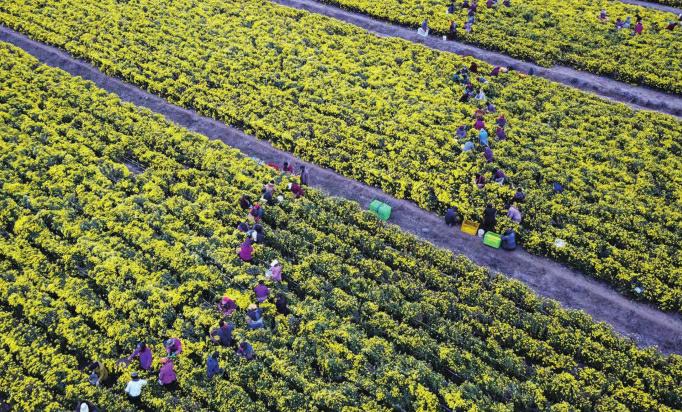Rural Vitality
2018-03-06
The Central Government recently released a package of policies on the development of rural areas, charting the course for the countrys rural vitalization strategy. This article, compiled from reports by Xinhua News Agency, takes a closer look at these initiatives.
China has outlined targets for a rural vitalization strategy, addressing issues related to agriculture, rural areas and farmers in this years installment of the annual No.1 central document jointly released by the Central Committee of the Communist Party of China (CPC) and the State Council on February 4. There is a lot to be accomplished in rural areas where opportunities for development have arisen as the country enters a new era, according to the document.
This is the 15th year in a row that the No.1 central document has been focused on agricul- ture, rural areas and farmers. The No.1 central document is the name traditionally given to the fi rst policy statement of the year released by the central authorities, and is seen as an indicator of policy priorities in the year to come.
Historic task
Rural vitalization was fi rst proposed as a major aspect of developing a modernized economy in a report delivered to the 19th National Congress of the CPC last October. In this latest document, the strategy is described as a “historic task” es- sential to accomplishing Chinas modernization goals and building a moderately prosperous society.
“China cannot develop without also modernizing its agriculture and rural areas,” said the document.
The timetable put forward by the central authorities at a rural work conference in December 2017 remains unchanged, but the objectives for different stages have become more specifi c.
President Xi Jinping, also General Secretary of the CPC Central Committee, attended the two-day rural work conference, delivering a speech in which he summarized the achievements in agriculture and rural areas since 2012 and expounded on the rural vitalization strategy with concrete requirements.
Despite considerable progress, a development gap remains between urban and rural regions due principally to lack of quality and effi ciency in agriculture. The conference called for the advance of integrated urban-rural development, with more focus on infrastructure, education and public services in rural areas.
By 2020, the strategy will have an institutional framework and policy system, with no Chinese living below the existing poverty line, while rural productivity and agricultural supply will be substantially improved.endprint
By 2035, decisive progress will be made, with the basic modernization of agriculture and rural areas. All Chinese, in cities and rural areas, will have equal access to basic public services, and urban and rural integration will improve.
By 2050, rural areas should have strong agriculture, a beautiful countryside and well-off farmers.
Policy designs
Han Jun, head of the Offi ce of the Central Rural Work Leading Group, said the document was“problem-oriented” and a “top-level design” for the country to achieve prosperity in rural areas.
“The document not only elaborates on the significance of the strategy, but also sets the tone, specifi es the targets and policies, and makes requirements for governments at lower levels,” he said.
The document places emphasis on the need for proper organization. Local governments have been required to specify their plans according to local realities, especially for the period from 2018 to 2022, and to coordinate policy-making with relevant spheres.
For instance, in well-developed villages, increasing public services may be a priority, while in villages with a long history and rich natural and cultural resources, development must be undertaken alongside preservation.
In villages with harsh living conditions and a fragile natural environment, more efforts shall be made toward relocation.
The document also highlighted better governance and strengthened leadership of the CPC in rural regions. Stronger punishments should be imposed to stop grassroots corruption that harms the interests of farmers, especially those concerning rural subsidies, collective asset management and land acquisition.
As the Chinese economy shifts toward high-quality development, the country is also aiming for more competitive agriculture driven by higher productivity and better quality.
According to the document, China will have more high-quality farmland, install more effi- cient water conservation facilities, and use more advanced agricultural equipment.
Farm produce will face tougher quality tests while more efforts will be made in the treatment of soil and water pollution.
Controls over rural homestead plots and housing will be loosened to make it easier for new businesses and industries, but they should not be used for building country villas and private clubs, according to the document.
“This is not a plan to encourage urban residents to buy rural properties, but rather to turn unused housing into places for rural tourism and elderly services,” said Han.endprint
China will also expand exports of high-quality farm produce and broaden rural cooperation with countries and regions involved in the Belt and Road Initiative.
More capital will be channeled into rural areas through steadily rising public fi nance inputs, broadened fi nancing, and better fi nancial services.
The package of policies also includes better education and medical services, green development, improved infrastructure and facilities such as toilets, and more training and incentives to build a workforce to support rural development.
Environmental upgrades A day after the No.1 central document was issued, the central authorities unveiled a three-year action plan to improve rural living environment.
“Although progress has been made, the living environment in rural China is very unbalanced with many areas dirty and disordered. It falls far short of peoples expectations and marks a key weakness in social and economic development,” the document said.
The country aims to make remarkable improvements in the rural living environment by 2020. Villages should be clean and tidy, and residents should have a better awareness of hygiene and health.
The document listed some key tasks including garbage sorting, toilet upgrades, residential sewage treatment and village management.
East China and developed areas in central and west China should fully implement these tasks. In less developed regions in central and west China, garbage sorting should be put into place in around 90 percent of villages. Around 85 percent of toilets must be improved to meet hygiene standards.
Remote and underdeveloped regions of the country should meet the basic standards for keeping the environment clean and tidy, on the basis of ensuring farmers basic quality of life.
The authorities told local and central government organs to increase fiscal input. Local governments are encouraged to issue government bonds to improve the environment.
Major financial institutions including the China Development Bank, the Agricultural Development Bank of China, the Agricultural Bank of China, and the Postal Savings Bank of China have been advised to increase credit and loans to support related projects.
Private companies are also encouraged to join the plan through the standardized implementation of public-private partnership schemes and franchised businesses.endprint
